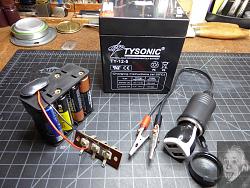Many modern electronic devices will cease to operate when their battery voltage falls below a certain value. When this happens, there is still useful energy stored in the battery and they can still power devices not sensitive to voltage, e.g. flashlights, toothbrushes, toys.
Being a child of depression era parents, I can't bring myself to throw them away so I end up with quite a collection of partially depleted AA batteries.
We get a fair share of blackouts in the summer when the snowflakes come home from work and turn on their ACs. I bought some 12 V, 5AH SLAs (Sealed Lead Acid) batteries to power emergency lights and small fans during these blackouts. To recharge USB devices like the Kindles we read until the power comes back I bought a cigarette lighter socket and a USB charger to fit it.
It occurred to me that if I put eight AA batteries in series, I'd have something close to 12 V, that would weigh a lot less (~0.5 lb) than the SLA (3.4 lb). Building a holder for eight batteries seemed a challenge until I learned that Amazon sells a made-to-order unit to do just that...
https://www.amazon.com/gp/product/B0...?ie=UTF8&psc=1
Eight AAs were selected at random from the bin and placed therein. The resulting voltage was only 11.24 V, but most down converters aren't picky about the supply voltage as long as it's more than the output (5 V for USB). Proof of the pudding was that it managed to easily charge my Kindle.
With unmatched batteries, I imagine some cells will be exhausted more quickly than others. Not a problem; I've got plenty of replacements.
I know - such penny pinching reminds me of the old "Use it Up wear it out Make it Do" poster from the WWII era but it makes me feel that I've struck a blow against the forces of planned obsolescence (not to mention emptying that drawer filled with batteries).



 LinkBack URL
LinkBack URL About LinkBacks
About LinkBacks



 Reply With Quote
Reply With Quote


Bookmarks